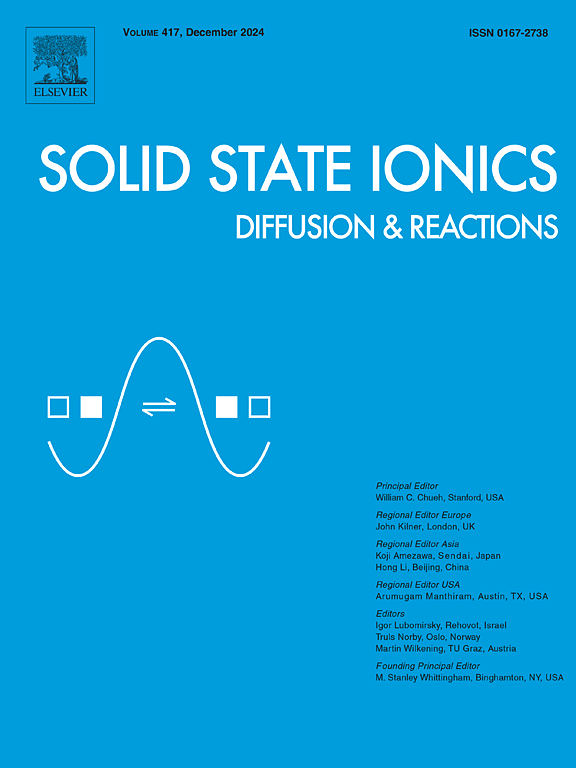铝离子掺杂钒氧化物作为高稳定性锌离子电池阴极
IF 3.3
4区 材料科学
Q3 CHEMISTRY, PHYSICAL
引用次数: 0
摘要
本文采用水热法制备了不同Al:V比掺杂Al3+的纳米层状钒氧化物(AlxV2O5)。用扫描电镜、x射线衍射和x射线光电子能谱对所得化合物的形貌和结构进行了表征。掺铝氧化钒的薄层以“纳米花”的形式凝聚在一起。证实了Al3+在层间距离扩大的氧化钒AlxV2O5层状结构中的存在。采用循环伏安法和恒流充放电法,在3 M硫酸锌水溶液中,对锌阳极的硬币型锌离子电池阴极材料的电化学性能进行了研究。阴极的初始容量取决于铝的含量(x值)。在电流密度为1.0 a·g−1时,Al0.060V2O5的初始容量最高,为383 mAh·g−1,由于Al3+离子含量较低,其降解速度较快,容量保持率为初始容量的89%。Al0.072V2O5的初始放电容量最低(196 mAh·g−1),但最稳定,容量保持率为98%(100次循环后为192 mAh·g−1),96%(300次循环后为189 mAh·g−1)。除第一次循环外,所有阴极的库仑效率均接近100%,证实了充放电过程的完全可逆性。本文章由计算机程序翻译,如有差异,请以英文原文为准。

Aluminum ion doped vanadium oxides as highly stable cathodes for aqueous zinc ion batteries
In this work, Al3+- doped nanosized layered vanadium oxides (AlxV2O5) with different Al:V ratios have been synthesized by hydrothermal method. The morphology and structure of the obtained compounds were characterized by scanning electron microscopy, X-ray diffraction and X-ray photoelectron spectroscopy. Thin layers of Al-doped vanadium oxide agglomerated in the form of “nanoflowers”. The presence of Al3+ in the layered structure of the vanadium oxide AlxV2O5 with expanded interlayer distance was confirmed. The electrochemical properties of the obtained cathode materials were investigated in coin-type zinc-ion battery cells with a zinc anode in an aqueous solution of 3 M ZnSO4 by cyclic voltammetry and galvanostatic charge/discharge. The initial capacity of the cathodes depended on the aluminum content (x-values). The highest initial capacity of 383 mAh·g−1 at a current density of 1.0 A·g−1 was observed for Al0.060V2O5, which degraded faster due to the lower content of Al3+ ions, and the capacity retention was 89 % of the initial value. Al0.072V2O5 had the lowest initial discharge capacity (196 mAh·g−1), but was the most stable with a capacity retention of 98 % (192 mAh·g−1 after 100 cycles) and 96 % (189 mAh·g−1 after 300 cycles). Except for the first cycle, the coulombic efficiency of all cathodes is close to 100 %, confirming the perfect reversibility of the charge/discharge process.
求助全文
通过发布文献求助,成功后即可免费获取论文全文。
去求助
来源期刊

Solid State Ionics
物理-物理:凝聚态物理
CiteScore
6.10
自引率
3.10%
发文量
152
审稿时长
58 days
期刊介绍:
This interdisciplinary journal is devoted to the physics, chemistry and materials science of diffusion, mass transport, and reactivity of solids. The major part of each issue is devoted to articles on:
(i) physics and chemistry of defects in solids;
(ii) reactions in and on solids, e.g. intercalation, corrosion, oxidation, sintering;
(iii) ion transport measurements, mechanisms and theory;
(iv) solid state electrochemistry;
(v) ionically-electronically mixed conducting solids.
Related technological applications are also included, provided their characteristics are interpreted in terms of the basic solid state properties.
Review papers and relevant symposium proceedings are welcome.
 求助内容:
求助内容: 应助结果提醒方式:
应助结果提醒方式:


